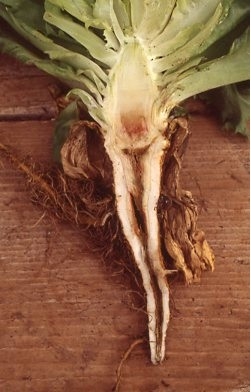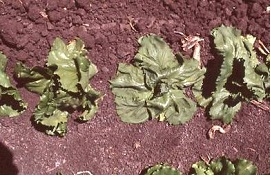Nitrogen fertilizer can have negative impacts on lettuce roots via salt effects and specific ion toxicity from nitrite and ammonium. In the early spring we commonly see ammonium toxicity in coastal lettuce production fields. In the past week, we received numerous samples of lettuce plants with this disorder. The core of the root of affected plants turns reddish brown to black, tissue becomes soft (necrotic), and the root becomes hollow as the plants age (Photo 1). The tops of affected plants suffer from water stress and become stunted; plants often wilt during the day due to the impaired root system (Photo 2). Lettuce plants with damage from ammonium may remain alive but will be stunted and behind in development; if the damage is severe and/or the plants are small, the lettuce can die. A key characteristic of ammonium toxicity is the distribution pattern in the field. Plants affected with this problem will occur randomly scattered throughout the field and will rarely occur in patches or groups.
While ammonium toxicity symptoms may resemble those of some lettuce diseases, in most cases ammonium toxicity is readily differentiated from fungal or bacterial problems of lettuce roots (Table 1). The main disease that may be confused with ammonium toxicity is Fusarium wilt. However, Fusarium wilt is characterized by occurring later in the summer, causing symptoms on both younger and older lettuce plants, occurring in patches and groups of plants, and thus far being found primarily in the southern part of Monterey County.
Table 1. Comparison of various characteristics of ammonium toxicity and soilborne diseases of lettuce
| Characteristic | Ammonium toxicity | Fusarium wilt | Verticillium wilt | Corky root |
| Stunted young plants | Yes | Yes |
No |
Yes, sometimes |
| Root vascular discoloration | Yes: red to brown to black | Yes: usually red to brown | Yes: usually black |
No |
| Root exterior surface | White, healthy | White, healthy | White, healthy | Yellow to brown, cracked |
| Affects mature plants |
No |
Yes | Yes | Yes |
| Field distribution | Random, scattered | In patches, groups | In patches, groups | May be uniform |
| Time of year | Early spring, sometimes June | Summer through fall | Summer through fall | Spring through fall |
The factors that contribute to the buildup of toxic levels of free ammonia and/or ammonium in the soil include fertilizer type, as well as soil type, temperature and moisture content. For instance, urea fertilizers results in the buildup of ammonium resulting from hydrolysis in the presence of the urease enzyme:
| CO(NH2)2 | + | 2H20 | + | H+ | ---------> | 2NH4+ | + | HCO3- |
| Urea | water | acid | urease | ammonium | bicarbonate |
If the pH of the zone where urea hydrolysis is taking place increases to above 8.3 (e.g. in the fertilizer bead), highly toxic amounts of free ammonia can temporarily form. High levels of ammonium in lettuce tissue can also be toxic. In the early spring when soil temperatures are less than 60 °F, nitrification of ammonium to nitrate is slowed and ammonium can build up in the soil following the application of urea or ammonium fertilizers. We have observed soil ammonium levels ranging up to 8 ppm or more in the winter and early spring, whereas in the summer it is rare to see soil ammonium levels exceed 1.0 to 1.5 ppm. Given the sudden onset of a number of fields with ammonium toxicity, it seems clear that weather and/or cool soil temperatures created conditions favorable to the buildup of toxic levels of ammonium in the soil.
Table 2 shows data from a 2001 on-farm evaluation where calcium nitrate was compared with the standard fertilizer program of ammonium nitrate to determine the effect on ammonium toxicity symptoms. In trial 1 we did see a significant reduction in the number of heads per plot with ammonium toxicity; however, there were still some toxicity symptoms even with the use of calcium nitrate, indicating that the form of fertilizer was important, but did not answer all the questions regarding the disorder in these trials.
In coastal California ammonium toxicity is typically an issue that occurs during the months of February and March. As the days lengthen and soil temperatures increase, issue with ammonium toxicity will decrease.
Table 2. Number of heads/plot with toxicity symptoms and levels of ammonium and nitrate in the soil 2 weeks following fertilizer application
| Fertilizer Type |
Heads with toxicity No. |
NH4-N ppm |
NO3-N ppm |
| Trial No. 1 | |||
| Calcium nitrate | 18 a | 0.79 a | 61.1 |
| Ammonium nitrate | 61 b | 3.43 b | 82.6 |
| Trial No. 2 | |||
| Calcium nitrate | 10 | 0.74 | 29.8 |
| Ammonium nitrate | 24 | 0.82 | 35.7 |

